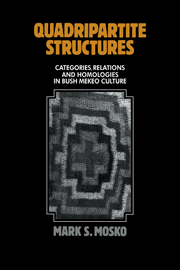Book contents
- Frontmatter
- Contents
- List of figures, tables, and maps
- Preface
- 1 Introduction: the problem and the people
- 2 Between village and bush
- 3 Body and cosmos
- 4 Sex, procreation, and menstruation
- 5 Male and female
- 6 Kin, clan, and connubium
- 7 Feasts of death (i): de-conception and re-conception
- 8 Feasts of death (ii): the sons of Akaisa
- 9 Tikopia and the Trobriands
- 10 Conclusions: indigenous categories, cultural wholes, and historical process
- Appendixes
- Notes
- Bibliography
- Index
10 - Conclusions: indigenous categories, cultural wholes, and historical process
Published online by Cambridge University Press: 04 August 2010
- Frontmatter
- Contents
- List of figures, tables, and maps
- Preface
- 1 Introduction: the problem and the people
- 2 Between village and bush
- 3 Body and cosmos
- 4 Sex, procreation, and menstruation
- 5 Male and female
- 6 Kin, clan, and connubium
- 7 Feasts of death (i): de-conception and re-conception
- 8 Feasts of death (ii): the sons of Akaisa
- 9 Tikopia and the Trobriands
- 10 Conclusions: indigenous categories, cultural wholes, and historical process
- Appendixes
- Notes
- Bibliography
- Index
Summary
Two kinds of interconnections have been shown in the preceding pages to ramify throughout Bush Mekeo culture, giving it both meaning and form. First, categories articulated together in one context (the body, for example) are invoked also in others (space and time, adult-male and -female ritual, social organization, death and mortuary ritual, etc.). Second, the sets of relations by which the categories of the culture are juxtaposed uniformly exhibit a structure of bisected dualities. These diverse contexts thus constitute semantic metaphors and structural homologies of one another (Levi-Strauss 1963a:83). The same may well also be ventured, on the basis of my comparative sketches, of Tikopia and the Trobriands. The purpose of this chapter is largely to explicate these findings. However, in the process of doing so, a number of collaterally important implications for cultural and social theory arise. These involve the analytical efficacy of indigenous culture categories, the nature of cultural systems as integrated, meaningfully structured totalities, and the relation of these structures to historical process. As I summarize my conclusions regarding Bush Mekeo culture, I shall directly address these issues as well.
Many of the significant semantic relations upon which this analysis is based have consisted of both kinds of “motivation” described by Gell (1975) and discussed in Chapter 1; that is, certain critical indigenous categories are either polysemous, or they are constituted of words compounded of other words. Examples of polysemy would include the systematic employment of spatial metaphors in body, waste/resource, village/bush, and clan-relationship classifications. In an identical way, the concept engama variously means procreative conception and mortuary de-conception and re-conception, as well as beginning in general.
- Type
- Chapter
- Information
- Quadripartite StructuresCategories, Relations and Homologies in Bush Mekeo Culture, pp. 234 - 249Publisher: Cambridge University PressPrint publication year: 1985



